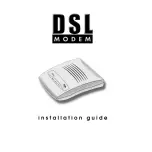
66
MultiModemBA User Guide
5.4.9
Flow Control Commands
Flow control refers to the techniques used by computer devices to stop and restart the flow of data to
and from each other. Flow control is necessary so that a device does not receive more data than it
can handle. In the case of the MultiModem, there is a need for flow control in both directions. As
illustrated on the next page, flow control for data passing from your computer to the modem is called
Modem-Initiated Flow Control and flow control for data passing from the modem to your computer is
called Computer/Terminal-Initiated Pacing.
The MultiModem supports both hardware and software Modem Initiated Flow Control. On the
Computer/Terminal-Initiated Pacing side, it supports hardware and software flow control, and a
special version used by Hewlett-Packard compatible systems called ENQ/ACK Pacing. The modem
allows hardware and software pacing to be passed through the modem to the other end of the link so
that your computer or terminal can control data start/stop activity through your modem.
This is called Xon/Xoff Pass-Through. To state it simply, “Flow Control” is something the modem
does to the computer, while “Pacing” is something the computer does to the modem.
RS-232/V.24
Modem-Initiated Flow Control
Computer
or
Terminal
Modem
Data Flow
Computer-Initiated Flow Control Pacing
RS-232/V.24
Computer
or
Terminal
Modem
Data Flow
Figure 5-2. Flow Control and Pacing
Hardware Flow Control &E4
With Hardware Flow Control, the modem uses its RS-232C interface to control the flow of data from
the computer or terminal to which it is attached. The CTS (Clear to Send) signal on Pin 5 of the RS-
232C interface is brought low to stop the flow of data, and is brought high to restart it. When you
select Hardware Flow Control as your Modem Initiated Flow Control method, you will also be
selecting it for Pacing.
The difference between the two, however, is that Modem-Initiated Flow Control uses the Pin 5 CTS
output signal, while Pacing uses the Pin 4 RTS input signal.
Modem commands are used to select the method of flow control used by the modem when its error
correction capabilities are used. These commands are covered in
Section 5.4.9
. If neither method is
selected, the modem defaults to no flow control (&E3).
Xon/Xoff Flow Control &E5
Xon/Xoff is the most commonly used method of flow control. Under this method, control characters
known as “Xon” and “Xoff” are inserted by the modem into the data to start and stop the flow of data
from the computer or terminal to which the modem is attached. Xoff, which is a Control-S, stops the
flow of data, and Xon, which is a Control-Q, restarts it. With regard to Binary Data, Xon/Xoff flow
control is not recommended because an Xoff character may be part of the data and would trigger an
Xoff of the modem or software package, which would halt data flow.
Содержание MultiModem II BA-Series
Страница 1: ...BA Series Intelligent Data Fax Modem User Guide...
Страница 6: ...vi...
Страница 7: ...Chapter 1 Introduction and Description...
Страница 18: ...18 MultiModemBA User Guide...
Страница 19: ...Chapter 2 Installation and Connection...
Страница 26: ...26 MultiModemBA User Guide...
Страница 27: ...Chapter 3 Software Configuration and Modem Basics...
Страница 34: ...34 MultiModemBA User Guide...
Страница 35: ...Chapter 4 Manual Dial and Automatic Answer...
Страница 40: ...40 MultiModemBA User Guide...
Страница 41: ...Chapter 5 Command Mode...
Страница 76: ...76 MultiModemBA User Guide...
Страница 77: ...Chapter 6 S Registers...
Страница 86: ...86 MultiModemBA User Guide...
Страница 87: ...Chapter 7 Callback Security and Remote Configuration...
Страница 96: ...96 MultiModemBA User Guide...
Страница 97: ...Chapter 8 Modem Testing...
Страница 106: ...106 MultiModemBA User Guide...
Страница 107: ...Chapter 9 DIP Switch Settings...
Страница 117: ...Chapter 10 Warranty Service and Tech Support...
Страница 123: ...Appendixes...
















































